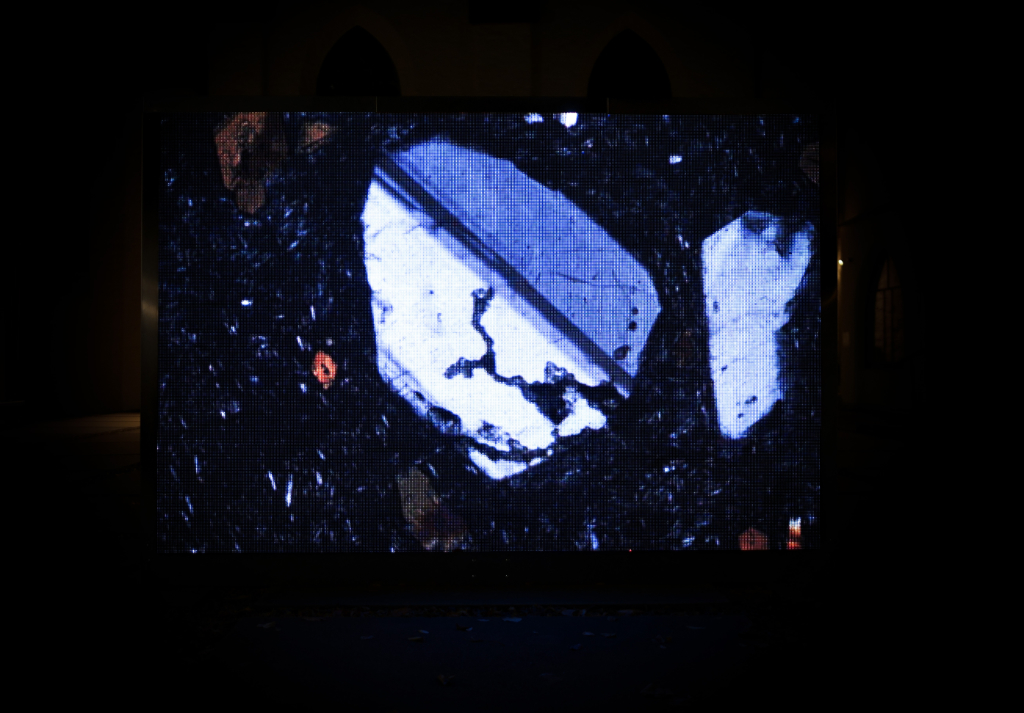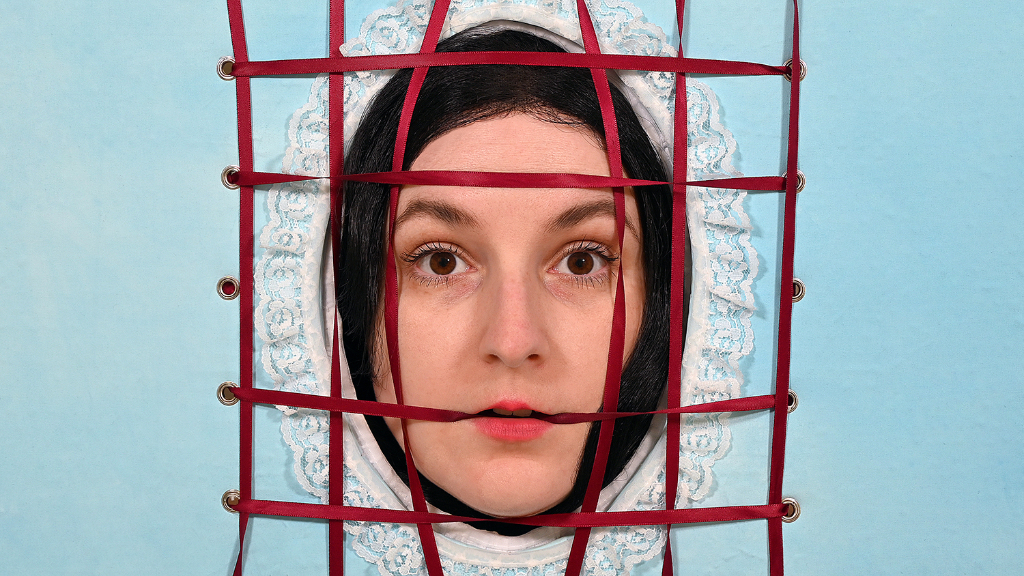Text by Anne Murray

The video work Seil (Rope, 27’30“, 2016)1 grabs my attention from the back of the gallery as I enter. I am drawn towards the constructed notion of time that reveals itself from the sequenced and nonsequenced images, both creating a whole in combination and slowing down perceptions through framing and cinematic timing. Based on Ambrose Bierce’s short story, An Occurrence at Owl Creek, the work at first appears political, but these overtones fall away as one regards the sequence of images overlapping to create a single scene.
Time is slowed and combined with a poignant focus on overlapping memory bridges. One has created a panorama with individual images to form a whole after scanning an event and composing each part to make a scene. The rendition is as important as the concept, enlivening understanding in a pedagogical method. This repetition highlights the constructed aspect of time as it is perceived, both in a shared reality and from individual focus as well as independent visions.
I look around to understand what I see in terms of its relational lines to the other works presented in the gallery, images of cities from many years of singular moments, capturing transitional times, whose significance might only be attributed from the distance of space and time. For example, a series of photographs on one wall are recognisable through the water, and light, which expose themselves as the Venetian landscape. These are simple, plain views every day, not the expected tourist visions, but rather the places just outside the frame of expectations, which might otherwise not have been photographed except for the drive of an artist’s vision.
I look back again at the video, Seil (English name- Rope) and apply some cultural perspectives. Bierce’s story is set during the American Civil War, and as an American, I find this choice of subject reference intriguing. In it, Katja Pratschke and Gusztáv Hámos recreate the sequence of the Bierce narrative through a slow progression, framing moments to gain access to inner visions.
Time is slowed down in this way, as the sequence of still and moving images progress. In addition, French chronophotographer Étienne-Jules Marey’s influence is felt and referenced in its experimental nature. This work positions itself in contrast to the work of Eadweard Muybridge, whose ‘photo series’ represent singular rhythms of action, captured still images which create a moving image, rather than the changing perspectives in Hámos and Pratschke’s video works.
Hámos and Pratschke explain this background; the story of Bierce tells the cognitive process of a slave owner while he was hanged in the North American Civil War; in short, ‘The Dead Man’s Dream.’ Furthermore, we have been experimenting with narrations since 2000 as in “Transposed Bodies” (at the moment exhibited at the Múzeum Ludwig Budapest) that show not only the drama but also the biochemical processes in the protagonists of a tragedy.
Seil depicts a series of still images, a photo film, showing the circumstances of the hanging of Peyton Farquhar on the Alabama Railway Bridge accompanied by a continuous narrative, interrupted by photographic sequences illustrating the experiments of the chronophotographer Étienne-Jules Marey.


I asked the artists about this work concerning their other works, At the turn of the millennium to the 21st century, we asked ourselves how much movement does a cinematic image need. In doing so, we question human perception in general and the perception of movement in particular. ‘Oh well, time,’ as Henry Bergson would say: ‘What an imperfect term (for) between space and duration.’
There is no such thing as objective time. The subjective perception of time has no reliably measurable duration. Our clock shows us a technically generated, abstract, fictitious time. Nevertheless, the abstract clocking of duration was of fundamental importance for the cinematographic representation of movement. The cinema provided us with a time unit of 24 frames per second.
With this remark, I am catapulted back to a documentary film class I took as a graduate student at Pratt Institute in New York City. I remember learning that the human brain can only process a specific number of frames per second. Otherwise, it is difficult to separate reality from fiction. This reference to frames per second seems highly relevant to the narrative perception of time, which the artists are exploring.
In the front corner of the gallery, another video is presented, with a space to sit and listen to headphones to take in the film for a longer period of time. The work is called Cities (Territories & Occupations), 29 min 50, 20192. The sound in the film seems highly relevant, and the artists explain in detail the reference, The musical concept of notations serves as a model for Cities Films, as a universal system for instructions. To name an example of such an instruction, the city of Syrma consists of 35 x 3 photographs, each cut in 7 stripes. Each series of 3 images was taken from the same camera position, showing the sky, the entrance of the house and the pavement.
Such a “program” is like a set of processing rules that prescribes a temporal-spatial composition. The space describing photo sequences also reinforces the time, which elapses during the recording of the individual photos, as in the city Marzia. In this way, each spatial description also automatically possesses cinematographic qualities.
The splicing of images reminds one of the old-time zoetropes, which would spin eternally and allow light to pass into the centre of a rotating wheel, with slits along the walls of this roulette-shaped construction. I consider how the first films were made, placing the new works into the context of the historical development of film, using drawings, photography and sound as essential blends in a recipe for the birth of modern cinema.
Here, the collection of striped images becomes a captured moment and indicates the time intervals separating them. The relationship between image and musical notation, a language of time we are already well aware of, becomes parallel to their image relationships with the long and short images, becoming sounds, with time for processing them accounting for their visual width.
Cities (Territories & Occupation) take shape through a relationship forged with the book Invisible Cities by Italo Calvino. We got inspired by Italo Calvino’s Invisible Cities method: We describe each city by concentrating on an aspect of urban life. They do not show “real” existing cities in specific places or from special historical epochs, but rather universal urban qualities, quintessences filtered out of various aspects of urban life, explains Hámos and Pratschke. The video combines these elements eloquently, displaying a universality to cityscapes and creating a sampling of urban existence. In
In Calvino’s book, the cities described are all Venice itself, but their details and descriptions convey the multitude of realities within a city, the overlapping stories and adventuresome narratives. Finally, in Hámos and Pratschke’s Cities, many sources exist, creating continuity between our worldwide urbanity in a fictional construct.
Our cities describe imaginary cities which have been documented with photographs in real urban areas. For Cities (Territories & Occupation), the photographs were taken in Bangalore, Delhi, Mumbai, Venice, Istanbul, Hamburg and Budapest. The artists explain that the future of the cities can be discerned in how we treat these urban concepts of perception in the present time.

Hámos and Pratschke describe these imaginary cities and give context to them, The city as a living organism reflects social processes and interactions, economic relations, political conditions and private matters. The source material for Cities (Territories & Occupation), as well as the SAMPLE CITIES book (2014) and the two Hidden Cities (2012) and Potential Space (2014) films, are sequential photo works depicting essential situations of urban experiences revealing human and inhuman acts in a compact form.
The cities in which the images were created between 1974 and 2019 include places with a traumatised past: Wars, dictatorships, terrorist catastrophes etc. These ‘traumatised spaces’ convey an essential reality to the cityscapes, rather than the polished images of tourism document elements that are present and show complicity in our shared vision of the urban experience.
Curious about the special format of the video works, I asked the artists to talk about their connections and presentations. Both are photo films. By photo films, we understand films that essentially consist of photographs. In both works, the stratigraphic method of chronophotography is reflected: We experiment with the illusion of movement by piling, compositing, and layering still images. All methods explore the image’s nature or condition in a cinematographic context. For us, the cinema of the future is characterised by the conscious change of the movement, or in other words, by the meaning of the movement in the image.
Indeed, the way the work is presented creates a beautiful flow of consciousness from different viewpoints in time, with the protagonist inside and outside himself, as in Bierce’s short story, where the main character, Farquhar, imagines a wealth of experiences of escaping after being hanged and meeting his wife again at the gate of his own home. In his reality, time slows down, displaying how imagination defies time and the rapid sequence of our internal thoughts. With the unique photo film format, we can participate in the duality of internal and external time, constructing and deconstructing the parallels and intersections of experiences.
One wonders how their collaboration worked in producing the works for this exhibition. Hámos and Pratschke give a historical background to this process. As media artists, we have worked together on the theory and practice of time-based media for 20 years. Our artistic praxis consists of works with film, photography, installations, walk-in cinema spaces, curating exhibitions, symposia, film series and the publication of books. Our collaboration is best described as being trustingly open to each other and letting ideas, projects, and works circulate between us.
Indeed, this element of trust seems crucial to successful collaborations, and these two artists have mastered it, blending ideas and voices with eloquent and influential results. They explain their process, We are artistic researchers, which means projects often unfold in the process; they are interwoven in a rhizomatic sense. We investigate how human cognition is changed by cinematography and which consequences the recording of image phases has for our perception of time, space and movement. We travel, encounter, research, experiment and reflect. We are open to transforming the unknown into the new.
Blending the scientific and artistic approaches to research and literary invention, their investigations become new explorations in the exhibition of human consciousness and its intersection with cinema. The hybrid result is captivating and alluring, drawing the viewer into fixation and reflection. A truly unique and beautiful experience of art and life is the result.






